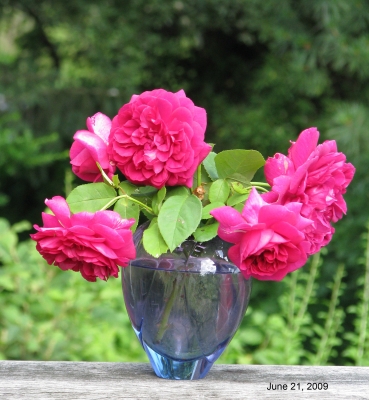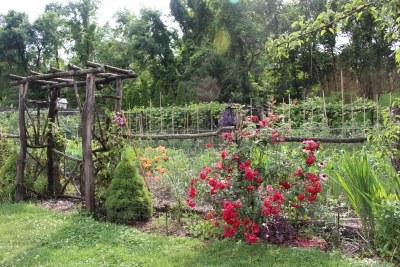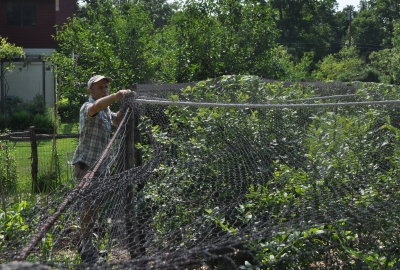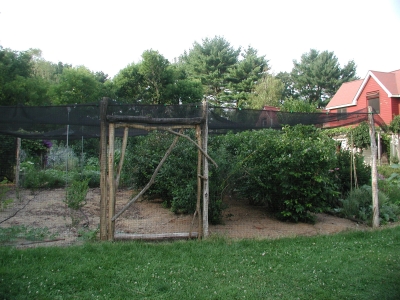Of Roses and Berries
Roses Come and Go
I once grew a beautiful, red rose known as Dark Lady. For all her beauty, she was borderline cold-hardy here. Many stems would die back to the graft, and the rootstock, which was cold-hardy, would send up long sprouts. Problem is that rootstocks are good for just that, their roots; their flowers, if allowed to develop, are nothing special. After a few years of watching the weakened plant recover each season, I made cuttings from some of the stems. The cuttings rooted and the new plants, rather than being grafted, were then growing on their own roots. Even a cold winter wouldn’t kill the roots, living in soil where temperatures are moderated. If the stems died back to ground level, new sprouts would still sport those dark, red blossoms.
After a few years of watching the weakened plant recover each season, I made cuttings from some of the stems. The cuttings rooted and the new plants, rather than being grafted, were then growing on their own roots. Even a cold winter wouldn’t kill the roots, living in soil where temperatures are moderated. If the stems died back to ground level, new sprouts would still sport those dark, red blossoms.
I planted my new Dark Lady in a bed on the south side of my house. There, with the brick wall of the house adding a few extra degrees of warmth in winter and spring, Dark Lady might better survive winters coldest nights and get a jump on spring. What’s more, the roots had ample soil to explore rather than being restricted within the narrow, dry bed along my terrace where the mother plant had grown.
The new Dark Lady grew reasonably well in its new bed, but still not as well as I had hoped. Dark Lady is one of the many “English roses” bred by David Austin to have the blowsy look and fragrance of old-fashioned roses coupled with disease resistance and repeat blooming of contemporary roses.
Dark Lady eventually petered out. She’s been superseded by some newer creations from David Austin: L. D. Braithwaite and Golden Celebration are standouts as far a hardiness and beauty, and I expect the same of Dame Judi Dench and Lady of Shalott.

L D Braithwaite rose
Global warming has, no doubt, also been a help.
No Sharing of My Highbush Blueberries
Pity the poor birds. My fat, juicy blueberries have been ripening and now there’s a net between them and them. Putting up the net always brings the words of fruit breeder Dr. Elwyn Meader to mind. When I visited him back in the 1980s, the old New Englander, still active in his retirement and growing about an acre of blueberries, among other crops, recounted in his slow, New Hampshire accent, “It takes a patient man to net an acre of blueberries.” Covering my two plantings encompassing a total of about a thousand square feet always creates a little tension.
Putting up the net always brings the words of fruit breeder Dr. Elwyn Meader to mind. When I visited him back in the 1980s, the old New Englander, still active in his retirement and growing about an acre of blueberries, among other crops, recounted in his slow, New Hampshire accent, “It takes a patient man to net an acre of blueberries.” Covering my two plantings encompassing a total of about a thousand square feet always creates a little tension. I now feel like a captain setting sail on an old sailing vessel, with all the sails trim and masts set. Except rather than sails and masts, it’s a blueberry net that’s spread tightly over the permanent, 7-foot-high perimeter of locust posts and side walls of anti-bird, plastic mesh. That netting covers 16 bushes within a 25 foot by 25 foot area. Rebar through holes near the tops of the locust posts keeps that side wall mesh taught and 18” high chicken wire along the bottom keeps rabbits, which love to teethe on that plastic mesh, from doing so.
I now feel like a captain setting sail on an old sailing vessel, with all the sails trim and masts set. Except rather than sails and masts, it’s a blueberry net that’s spread tightly over the permanent, 7-foot-high perimeter of locust posts and side walls of anti-bird, plastic mesh. That netting covers 16 bushes within a 25 foot by 25 foot area. Rebar through holes near the tops of the locust posts keeps that side wall mesh taught and 18” high chicken wire along the bottom keeps rabbits, which love to teethe on that plastic mesh, from doing so. Don’t worry about the birds. They get their fill of berries elsewhere. I don’t net my lowbush blueberries, nor my mulberries or gumis. Birds don’t usually share the mulberries or gumis with me. This year, for some reason, they are sharing.
Don’t worry about the birds. They get their fill of berries elsewhere. I don’t net my lowbush blueberries, nor my mulberries or gumis. Birds don’t usually share the mulberries or gumis with me. This year, for some reason, they are sharing.
Juneberry, a Blueberry Look-alike
Birds also have free access to a blueberry look-alike, juneberries, the plants of which are sometimes called serviceberry, shadbush, and, in the case of one species, saskatoon. The bushes are common in the wild and, because of their pretty flowers, fall color, and neat form, also planted in landscapes.
Juneberries are small, blue, and dead-ringers for blueberries but have a taste all their own: Sweet with the richness of sweet cherries, along with a hint of almond. The birds seem to enjoy them as much as they do blueberries. Juneberries are related to apples and pears, not blueberries, and share some of their kin’s pest problems. Especially in my garden. They’re one fruit that didn’t grow well for me so, years ago, I finally dug the plants up.
Juneberries are related to apples and pears, not blueberries, and share some of their kin’s pest problems. Especially in my garden. They’re one fruit that didn’t grow well for me so, years ago, I finally dug the plants up.
Neither I nor birds need go far to find wild juneberries or bush or tree types planted for landscaping. They usually bear pretty well because of growing in microclimates more suitable than here on the farmden. In this low-lying valley, the air is too humid, cool, and conducive to disease.
With all the rain this spring, I’ve noticed that the crop on wild and cultivated juneberry plants has been hit hard by rust disease. I hear tell, though, that plants were bearing well at a nearby shopping mall: There, sunlight beating down on nearby concrete and, perhaps, less rust spores wafting about, create a microclimate conducive to good crops of berries.
——————————————
Any gardening questions? Email them to me at garden@leereich.com and I’ll try answering them directly or in this column. Come visit my garden at www.leereich.com/blog.

